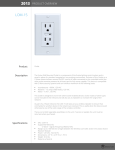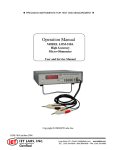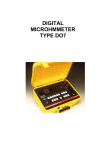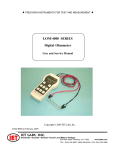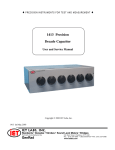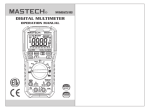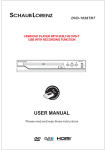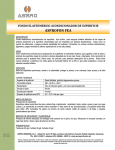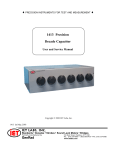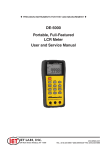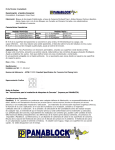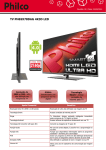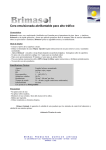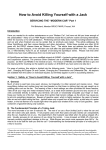Download LOM-DO7 Manual
Transcript
♦ PRECISION INSTRUMENTS FOR TEST AND MEASUREMENT ♦ LOM-DO7 SERIES Digital Micro-ohmmeter User and Service Manual IET LABS, INC. 534 Main Street, Westbury, NY 11590 www.ietlabs.com TEL: (516) 334-5959 • (800) 899-8438 • FAX: (516) 334-5988 ♦ PRECISION INSTRUMENTS FOR TEST AND MEASUREMENT ♦ LOM-DO7 SERIES Digital Micro-ohmmeter User and Service Manual Copyright ' 2005 IET Labs, Inc. LOM-DO7 im/December, 2005 IET LABS, INC. 534 Main Street, Westbury, NY 11590 www.ietlabs.com TEL: (516) 334-5959 • (800) 899-8438 • FAX: (516) 334-5988 ♦ PRECISION INSTRUMENTS FOR TEST AND MEASUREMENT ♦ IET LABS, INC. 534 Main Street, Westbury, NY 11590 www.ietlabs.com TEL: (516) 334-5959 • (800) 899-8438 • FAX: (516) 334-5988 LOM-DO7 WARRANTY We warrant that this product is free from defects in material and workmanship and, when properly used, will perform in accordance with applicable IET specifications. If within one year after original shipment, it is found not to meet this standard, it will be repaired or, at the option of IET, replaced at no charge when returned to IET. Changes in this product not approved by IET or application of voltages or currents greater than those allowed by the specifications shall void this warranty. IET shall not be liable for any indirect, special, or consequential damages, even if notice has been given to the possibility of such damages. THIS WARRANTY IS IN LIEU OF ALL OTHER WARRANTIES, EXPRESSED OR IMPLIED, INCLUDING BUT NOT LIMITED TO, ANY IMPLIED WARRANTY OF MERCHANTIBILITY OR FITNESS FOR ANY PARTICULAR PURPOSE. iii LOM-DO7 Contents WARRANTY ...........................................................................................iii Contents ............................................................................................... iv Figures ............................................................................................... iv WARNING .............................................................................................. vi CAUTION ............................................................................................... vi Chapter 1 INTRODUCTION .......................................................................... 1 1.1 General Description ............................................................... 1 1.2 Theory of Operation .............................................................. 1 1.3 Case Design ........................................................................... 1 1.4 Available Accessories ............................................................ 1 Chapter 2 SPECIFICATIONS ......................................................................... 2 2.1 General: .................................................................................. 2 2.2 Measurement: ........................................................................ 2 Chapter 3 OPERATION ................................................................................... 3 3.1 Initial Inspection .................................................................... 4 3.2. Safety .................................................................................. 4 3.3 Features ................................................................................ 4 3.3.1 Measurement Polarity .................................................. 4 3.3.2 Range Selection: ........................................................... 4 3.3.3 Error & Status Lamps .................................................. 4 3.4 Making Measurements ........................................................ 5 3.4.1 Ohmmeter Connections................................................ 5 3.4.2 Start-up ......................................................................... 5 3.4.3 Measurement ............................................................... 5 3.4.4 Current Mode ............................................................... 6 3.4.5 Over-Range.................................................................. 6 3.4.6 Open-Circuit Lead ....................................................... 7 3.4.7 Low Battery and AC Operation ................................... 7 3.4.8 Connections .................................................................. 7 3.5 Remote Operation and Printer Output .................................. 7 3.5.1 Remote Operation ......................................................... 7 3.5.2 Printer Output ................................................................ 7 3.6 Protection ............................................................................... 8 Chapter 4 CALIBRATION .............................................................................. 9 4.1 Calibration Process ................................................................ 9 4.2 Equipment Required ............................................................... 9 4.3 Preparation ........................................................................... 9 4.4 Calibration Using MTS2 Standard ....................................... 10 4.5 Calibration Using Discrete Resistance Standards ............... 10 iv LOM-DO7 Chapter 5 MAINTENANCE .......................................................................... 12 5.1 General ............................................................................... 12 5.2 Battery Charging ................................................................ 12 5.3 Battery Replacement .......................................................... 13 Figures Figure 3.1 Description of Controls ............................................................ 3 Figure 3.2 Combined current and potential probes (Kelvin clips) ............ 5 Figure 3.3 Connections for resistance measurements with various DUT configurations .......................................................................... 6 Figure 3.4 Remote Start Socket, viewed from panel ................................ 7 Figure 3.5 Printer Output Connections ..................................................... 8 Figure 4.1 Preferred calibration setup. ..................................................... 9 Figure 4.2 Full Scale calibration setup .................................................... 11 Figure 4.3 Zero calibration setup ............................................................ 11 v LOM-DO7 WARNING OBSERVE ALL SAFETY RULES ‘WHEN WORKING WITH HIGH VOLTAGES OR LINE VOLTAGES. ELECTRICAL SHOCK HAZARD. DO NOT OPEN CASE. REFER SERVICING TO QUALIFIED PERSONNEL. HIGH VOLTAGE MAY BE PRESENT WITH HIGH VOLTAGE OPTIONS. WHENEVER HAZARDOUS VOLTAGES (> 45 V) ARE USED, TAKE ALL MEASURES TO AVOID ACCIDENTAL CONTACT WITH ANY LIVE COMPONENTS: - USE MAXIMUM INSULATION AND MINIMIZE THE USE OF BARE CONDUCTORS. REMOVE POWER WHEN HANDLING UNIT. POST WARNING SIGNS AND KEEP PERSONNEL SAFELY AWAY. CAUTION DO NOT APPLY ANY VOLTAGES OR CURRENTS TO THE TERMINALS OF THIS INSTRUMENT IN EXCESS OF THE MAXIMUM LIMITS INDICATED ON THE FRONT PANEL OR THE OPERATING GUIDE LABEL. vi LOM-DO7 Chapter 1 INTRODUCTION 1.1 General Description The LOM-DO7 is an accurate bench/portable Digital Ohmmeter for the measurement of resistance in the range 0.1 µΩ to 60Ω. It utilizes the four-terminal (Kelvin) resistance-measurement method to eliminate the effects of lead resistance. The measured values are displayed on a 4-digit, 6000-count LED display; there is also an overflow indicator. Simple push-button selection of the range required makes the LOM-DO7 easy to use. Error and status warnings are illuminated when appropriate. The unit will withstand accidental application of line voltage to the measuring terminals. 1.2 Theory of Operation The measurement is true 4-terminal, using the Kelvin principle. A stable current is produced across the resistance to be measured via the C terminals, and the voltage drop across the unknown resistance Rx is measured at the P terminals. This potential drop is then compared against the voltage drop across internal standards. The ratio of these is then converted to the resistance value of Rx and displayed in ohms on the digital display. Use of specially selected components assures high accuracy and longterm stability . 1.3 Case Design The case is ruggedly constructed from a “safety yellow” ABS/polycarbonate composite . A strong internal sub-frame ensures that the LOM-DO7 will withstand the harshest environments. The Calibration front panel is a reverse-printed polycarbonate overlay with clear and unambiguous text. 1.4 Available Accessories Supplied: 1 1 1 Set of test leads Power cord Operation Manual Optional Lead Sets: HSO1 HSO1-RS HSO2 HSO2-RS LSO3 LSO4 Kelvin Clip Set with 3-meter leads Similar to HSO1, but includes remote-start button Kelvin Clip Set with 3-meter and 15-meter leads Similar to HSO2, but includes remote start button Large Kelvin clips with 3-meter leads– accept cables and bars up to 38 mm in diameter Similar to LSO3 but with 3-meter and 15-meter leads Other Optional Accessories: FSO1 Foot Switch for remote actuation CO1 1 Meter Cable-Test Fixture – Wood Base CO2 1 Meter Cable-Test Fixture – Metal Base CBO2 Accessory Pouch—attaches to cover MTS2 Calibration Standard PRO2 Portable Thermal Printer RS101 RS232 Cable 1 LOM-DO7 Chapter 2 SPECIFICATIONS 2.1 General: 2.2 Measurement: Digital Display: 4 digit, 0.8" high LED, 6000 count with automatic decimal point and errorwarning lamps Operating temperature range: 0 to +40°C, with maximum relative humidity of 80% Storage temperature: -20°C to +50°C AC power: 103-127 V or 207-253 V, 47-63 Hz Power consumption: <40 VA Dimensions: 343 x 327 x 152 mm (13.5” x 12.9” x 6.0”) Weight: 8.3 kg (18.3 lb) Resistance: True four-terminal measurement with fixed dc measuring currents Measuring time: Approximately 0.5 seconds Polarity: Selectable positive or negative current flow, plus an average mode which automatically displays the average value of the positive- and negativepolarity measurements. Ranges and Accuracies Range 60 Ω 6 Ω 600 mΩ 60 mΩ 6 mΩ 600 µΩ Resolution 10 1 100 10 1 0.1 mΩ mΩ µΩ µΩ µΩ µΩ Typical Current 1 mA 10 mA 100 mA 1 Amp 10 Amp 10 Amp Uncertainty At 20°C ± 5°C, 1 Year ±(0.15% Rdg + 0.05% FS) ±(0.15% Rdg + 0.05% FS) ±(0.15% Rdg + 0.05% FS) ±(0.15% Rdg + 0.05% FS) ±(0.2% Rdg + 0.1% FS) ±(0.2% Rdg + 0.2% FS) Temperature Co-efficient/°C* 40 ppm Rdg 40 ppm Rdg 40 ppm Rdg 40 ppm Rdg 40 ppm Rdg 40 ppm Rdg + 30 ppm + 30 ppm + 30 ppm + 30 ppm + 30 ppm +250 ppm FS FS FS FS FS FS * NOTE: Add temperature coefficient specification value to uncertainty specification value when operating outside the 15°C to 25°C temperature range. NOTE: Measurements on the lowest range (600 µW) may have an additional zero offset of up to 20 counts if the measuring current is applied repeatedly for long periods. This offset can be eliminated by using the average-measuring mode. 2 Specifications LOM-DO7 Chapter 3 OPERATION Measuring Terminals 4 Digit LCD Display Measuring Terminals AC Power Input Remote Start Socket Battery Status Indicator RangeSwitches RS232/Printer Socket Calibration Lock On/Off Power Switch Figure 3.1 Description of Controls Operation 3 LOM-DO7 3.1 Initial Inspection After unpacking, inspect unit for shipping damage and report any problem immediately to the carrier, retaining packaging materials for inspection. 3.2. Safety This unit is designated Safety Class I as defined in the IEC Publication 1010-1, Amendment 1. This unit has been designed and tested in accordance with IEC Publication 348, entitled "Safety Requirements for Electronic Measuring Apparatus", and has been supplied in a safe condition. The present instruction manual contains some information and warnings, which should be followed by the user to ensure safe operation and to keep the unit in safe condition. Before switching on the unit, make sure that it is set to the correct line voltage, and that the correct fuse for that voltage has been installed (See the table in Chapter 6). The unit must be plugged in to a grounded outlet only, and any extension cord used must be the 3-wire grounding type. 3.3 Features 3.3.1 Measurement Polarity The measuring-current polarity can be selected from the front panel. The display will indicate either “+” or “-“ to show the direction of current flow. This is particularly useful when evaluating circuits with thermal emf, or circuits where diode effects can influence the measurement. For 4 measurements where thermal emf can cause a large zero-error, there is an automatic-average (AVE) button. When it is pressed, the measuring current will automatically be reversed and the average value displayed, thus eliminating the need for external computations. This averaging feature also adjusts the measurement time automatically, giving the fastest possible measurement even for inductive circuits. The +VE and -VE lamps will light to indicate that the current polarity is changing. For very unstable values where the average mode is unable to establish a stable reading, the averaging will be aborted after approximately 25 seconds and the display will show “- - - -“. A new AVE cycle will be started automatically. 3.3.2 Range Selection: Any of the six measuring ranges can be selected manually by simply pressing the desired RANGE button. The selected range is indicated by an lit LED. Over-range is indicated by the display reading “- - - -“. 3.3.3 Error & Status Lamps The following LEDs will light to indicate the instrument status: LINE: ac power is connected to the instrument. O/C: One of the measuring leads is open LEAD: Open-circuited (too high a resistance), or not connected to the test sample correctly, or the internal protection fuse is open. This lamp will always be lit in the STBY (Standby) mode. Operation LOM-DO7 3.4 Making Measurements 3.4.1 Ohmmeter Connections The LOM-DO7 employs a four-wire method of measurement, i.e. four connections to the resistor under test are required. The unit is supplied with four leads: two voltage leads to be placed across the exact measurement points, and two current leads to be placed “outside” the measurement points. The Kelvin clips, shown in Figure 3.2, place voltage and current connections at the same point. a) Connect the black leads to the +C and +P terminals, and the red leads to terminals -C and -P. b) Clip the test leads onto the resistor under test. Cleanliness is important; if the DUT is not clean, clean it with fine emery cloth or steel wool to remove oxides. c) It is not always possible to use the combined current and potential (Kelvin) clips, in which case test leads with spade lugs—or a special test fixture - may have to be made for a particular application. d) Fig. 3.3 illustrates connections to various types of test resistors e) When measuring 4-terminal resistance standards, the Kelvin clips may not be usable because of terminal geometry. Make four separate connections to the current and potential terminals 3.4.2 Start-up When the LOM-DO7 is first switched on, an internal self-test is automatically performed. The display indicates -8888 followed by PASS, then performs an automatic zero sequence and finally sets to the following default start-up conditions: Operation Fig. 3.2 Combined current and potential probes (Kelvin clips) 60Ω Ω range and STBY (Standby) mode. The unit is now ready to make measurements. The display will blank after approximately. 25 seconds of inactivity. If the internal checks indicate an error, the display will read HELP. Contact our Service Department or your IET Representative for assistance. 3.4.3 Measurement Connect the resistance to be measured to the measuring terminals in accordance with the diagram on the instrument panel and using the most appropriate connection technique for the unknown (See Figs. 3.1 and 3.2). Select the range required and the current measurement mode, i.e.. “+”, “-“, or AVE. LEDs will light to indicate which functions are active. To initialize the measurement, press the ON switch. A single measurement will be taken and the value held on the display for approximately 25 seconds. After 25 seconds, the display will go blank and only the RANGE LED will remain lit. The last measured value can be recalled by pressing the ON switch. To make another measurement the ON switch should be pressed again. To take continuous readings, press and hold the LOCK and ON switches until a beep is heard; this will activate a continuous-reading mode. 5 LOM-DO7 Fig. 3.3 Connections for resistance measurements with various DUT configurations Measurements will continue, and periodic beeps will be heard, until the ON or STBY key is pressed. Remember that the current drain on the internal battery can be up to 10 A on the lowest ranges. To preserve battery life, the unit will automatically turn off after 5 minutes of inactivity. Note: the ON key LED remains lit while measurements are being made. 3.4.4 Current Mode The current mode can be set to “+I”, or AVE. The AVE mode should be selected for all mea- 6 surements that are not inductive, as this eliminates errors due to thermal emf in the measurement circuit or test leads. In the AVE mode the LOM-DO7 takes readings with the current flowing in both directions and displays the average of the two readings. For measurement of inductive circuits the measuring current should either be set in “+I” or “-I” mode. 3.4.5 Over-Range If the measured value exceeds the upper limit of the range selected, the display will indicate “- - -“. Select a higher range. Operation LOM-DO7 3.4.6 Open-Circuit Lead If one of the test leads is open-circuited, or exceeds a preset resistance, the O/C LEAD LED will light and the display will indicate “- - - -“. ( The C terminals are checked for compliance voltage). Measurements cannot be made if this warning message is displayed. This warning will also be displayed if the internal protection fuse is open. When in STBY mode, this LED will always be lit. 3.4.7 Low Battery and AC Operation The LED bar graph display indicates the stateof-charge of the battery. Batteries must be fully charged for proper operation on the lowest two ranges due to the high current required. The other ranges may be used during battery charging (ac operation), however an additional error of up to eight digits will be introduced. 3.4.8 Connections 3.5 Remote Operation and Printer Output Figure 3.4 Remote Start Socket, viewed from panel 3.5.1 Remote Operation If a normally-open switch, such as a footswitch, test leads with a “start” button, or some other type of contact closure is connected to pins 1 and 2 of the REMOTE socket, it will mimic the function of the ON key when activated. See Figure 3.4. 3.5.2. Printer Output The print format will be as follows: Sign Value To make the most accurate possible measurements, ensure that all test leads are in good condition, and have less than 0.2Ω resistance. Some spade lugs and crocodile clips - especially nickelplated brass types - can produce high thermal emfs when heated. This can sometimes cause problems , for example when connecting to hot motor windings. Avoid such problems by using plain copper or brass connections and keeping them clean and oxide-free. The heavy-duty binding posts used are designed to accept standard banana plugs in the top socket, and bare wires and spade lugs may be clamped when inserted from the side. Operation - 600.0 600.0 600.0 Units (Mode) mΩ mΩ mΩ (+VE) (-VE) (AVE) The value printed will be followed by a line feed and carriage return. If the DO7 displays an over-range condition, it will print as “ - - - - “. For cable connection details see page 8. Print All All measured values will be sent to the printer (RS232) when the PRINT ALL switch is ON, as indicated by the LED on the switch. This key toggles ON/OFF. 7 LOM-DO7 Print Last The last measured value only will be sent to the printer. This is defined as the last value measured when switching from ON to STBY. This key toggles ON/OFF. Baud Rate This key will display the currently set Baud Rate when pressed. To change the value, press CLE, and then use the keyboard to enter the new value, finishing with OK. If the newly entered value is valid, it will be stored in non-volatile RAM. If it is invalid, a long beep will sound and the existing rate will be retained. The valid Baud Rates are: 75, 110, 150, 300, 600, 1200, 2400, 4800, 9600, 19200. The format is fixed at 8-bit data, 1 start bit, 1 stop bit, and no parity. 3.6 Protection This instrument is protected against voltages being applied inadvertently to the terminals. A high-interrupting-capacity fuse is installed internally in the current circuit and a gas discharge tube (GDT) is installed across the current terminals. If voltages above ~90 V are applied to the measuring terminals, the GDT will strike, effectively shorting the C (or I) terminals through the protective fuse, which will open and interrupt the circuit. The voltage terminals are not fused, and will withstand up to 460 Volts without damage to the instrument. !WARNING! To replace the protection fuse, the top cover should be removed, but only after ac power and all input connections are removed. The protection fuse is located on the main printed circuit board. This fuse has a 40,000-to-200,000 A interrupting capacity, depending on the exact type used. Always replace this fuse with one of the same current rating (10 A) and at least a 40,000 A interrupting capacity. Figure 3.5 Printer Output Connections 8 Operation LOM-DO7 Chapter 4 CALIBRATION vironment (20°C ±5°C) for a minimum of 4 hours. Ensure that the batteries are fully charged. 4.1 Calibration Process This procedure describes the standard calibration method for the LOM-DO7 Micro-ohmmeter using the IET MTS2 Calibration Standard or discrete resistance standards of the required values. !CAUTION! The LOM-DO7 comes factory-calibrated to its full accuracy, and any recalibration by the user will invalidate this initial calibration. The user should therefore be certain that only authorized and competent personnel are permitted access to the calibration process, which is keylock-protected. 4.2 Equipment Required - IET Calibration Standard MTS2, or equivalent 4-terminal standard/s. - Set of 2 low-thermal-emf leads - Set of 2 general-purpose leads (10 A rating) 4.3 Preparation 4.3.1 Ensure that the unit is completely assembled. Place it in a temperature-controlled en- 4.3.2 Connect each of the four LOM-DO7 terminals to the equivalent terminals on the calibration standard. It is essential that low thermal emf leads are used for the P1 and P2 leads. See Figure 4.1 for the preferred setup. 4.3.3 An internal battery powers the LOM-DO7 and this should be fully charged before calibration. The ac charger can be left connected, if desired. 4.3.4 Set the calibration standard to 40 Ohm, Zero. 4.3.5 Turn the LOM-DO7 ON by pressing the ON/OFF switch. If the HELP message is displayed, perform a special CAL RESET operation as follows: 1. Insert the Calibration Key into the panel Switch and turn it to the CAL position. The CAL LED should light. 2. Press the CLE Switch. Its LED should light for ~ one second. The “HELP” message should now be replaced by a normal display. 3. Turn the panel switch back to the RUN position. Figure 4.1 Preferred calibration setup. Calibration 9 LOM-DO7 4.3.6 Let the setup stabilize for a few minutes. 2. Set the MTS2 to 40 Ohm, Zero. 4.4 Calibration Using MTS2 Standard 3. Set the DO7 to the 60 Ω range, +VE, and press LOCK+ON. Wait for the reading to stabilize. The reading should be “0.00” ±1 digit. Record this reading and subsequent readings if required. 4.4.1 Calibration 4. Set the MTS2 to +FS and wait for the reading to stabilize. The reading should be “40.00” ±1 digit. 1. Turn the panel switch to the CAL position. The CAL LED should light. 2. Set the LOM-DO7 to the 60Ω range, +VE, and press the LOCK and ON switches at the same time; hold them down until you hear a beep. 6. Set the DO7 to AVE and wait for the reading to stabilize. The reading should be “40.00” ±1 digit. 3. When the reading stabilizes, press the KYB switch. The display should show “0”. 7. Reset the DO7 to +VE. Set the MTS2 to 4 Ω,, +FS and wait for the reading to stabilize. The reading should be “4.00” ±1 digit. 4. Press the OK switch. The OK LED should light for about 3 seconds. 5. The display should now show “0.00” ±1 digit. If not, repeat steps 3 and 4. 6. Set the MTS2 to +FS. 7. When the reading has stabilized, press the KYB switch. 8. Enter the value “40” using the keypad, and then press OK. The OK LED should light for ~three seconds. 9. The display should now show “40.00” ±1 digit. If it does not, repeat steps. 10. Repeat steps 2 through 9 for the remaining ranges, in each case setting the MTS2 to the appropriate value. 11. Turn the panel switch to RUN and remove the key. 4.2.2 Verification 1. Verify that the panel switch is set to RUN and the calibration key is removed. 10 5. Set the DO7 to -VE and wait for the reading to stabilize. The reading should be “-40.00” ±1 digit. 8. Set the MTS2 to 400 mW, +FS and wait for the reading to settle. The reading should be “0.40” ±1 digit. 9. Set the MTS2 to 40 mΩ , +FS and wait for the reading to settle. The reading should be “0.04” ±1 digit. 10. Repeat steps 2 through 10 for the remaining ranges, Setting the MTS2 appropriately. 11. Turn the DO7 power OFF and remove the test. 12. Document the results in accordance with company policies and procedures.. 4.5 Calibration Using Discrete Resistance Standards 4.5.1 Discrete, 4-terminal resistance standards may be used in place of the IET Calibration Standard. The standards must have an uncertainty better than 0.01% if the full calibration accuracy is to be achieved. Full consideration of the LOM-DO7 Calibration LOM-DO7 measuring current must also be taken into account when selecting the standards. The LOMDO7 can be calibrated to standards between 1000 and 6000 digits for each range using the KYB entry. However, full accuracy will only be achieved if standards of 4000 to 6000 digits are used. The following nominal standards are recommended: 400 Ω, 40 Ω, 4 Ω, 400 mΩ, 40 mΩ and 4 mΩ. 4.5.3 For FS measurements, connect the C1 (or I1) and C2 (or I2) leads in the conventional manner (see Fig 4.2). 4.5.4 For ZERO measurements, connect the C1 (or I1) and C2 (or I2) leads to the C2 terminal of the standard (see Fig. 4.3). 4.5.2 In all measurements the P1 and P2 terminals are conventionally connected. Bear in mind that thermal emf’s may be present. The LOM-DO7 is particularly sensitive to these on the 6 mΩ range. 4.5.5 Using the above described connections for ZERO and FS (Full Scale) measurements, perform steps 4 through 10 of the above procedure (which uses the MTS2 standard) to complete the calibration. Figure 4.2 Full Scale calibration setup Figure 4.3 Zero calibration setup Calibration 11 LOM-DO7 Chapter 5 MAINTENANCE 5.1 General 5.2 Battery Charging Normally no maintenance is required other than cleaning with a moist cloth. Avoid strong detergents or solvents. The LOM-DO7 has a built-in, rechargeable, sealed-lead-acid battery, which is fully charged when delivered. To ensure good service life from the battery, the LOM-DO7 incorporates a sophisticated battery management system. Battery condition is indicated by a LED bar graph display. If a failure occurs, or if the unit cannot be calibrated, it should be returned to IET or to an IET representative. Contact IET for an RMA number before returning the unit directly to IET. There is a line fuse in the ac power input socket on the front panel, and an input-protecting fuse on the circuit board. Examine and replace these fuses if necessary, before a final decision to return the unit for repair. CAUTION: Disconnect ac power cord and all connecting leads before removing a fuse. Replace only with the correct fuse types as shown below. Fuse (250 V) Nominal IEC 127 Voltage Line 5 x 20 mm Voltage Range 120 V 104-132 V 1.25 A(T)(sb) 220 V 191-242 V 630 mA(T)(sb) Maximum input power: 40 W The input circuits are protected by a 10 A fuse located in a holder on the main printed circuit board. Remove the top cover for access. Replace only with the correct fuse type as shown below: NFC63210, Altech 10C10x38GI or Cooper Bussman KTK-10 12 The battery charger is built-in and the instrument may be connected to a 120 or 220 volt ac supply. The appropriate voltage setting must be selected on the ac input socket and the correct fuse inserted. The “LINE” LED on the front panel will light to indicate when the unit is connected to ac power. Charging is automatically controlled, with builtin protection circuits eliminating the possibility of overcharging. The display will go blank when the battery voltage is too low to allow accurate measurements. The battery will recharge in approximately six hours; leave the LOM-DO7 lid open to permit maximum ventilation. IMPORTANT: Always connect the unit to ac power after use to charge the battery. It should be stored with batteries fully charged; when the instrument is stored or not used for long periods, the batteries should be recharged monthly. If the batteries become deeply discharged due to being left uncharged for long periods, the internal charger will automatically sense the battery state and will trickle-charge with a very low current to restore the batteries before automatically switching to fast charge. This low- current charge may take up to 20 hours to restore the batteries. Maintenance LOM-DO7 Continuous charging will not damage the batteries, and is recommended in order to keep them in the best condition. !BATTERY CAUTIONS! The internal battery is the sealed-lead-acid type. When disposal is required, be sure to do so in accordance with local regulations. Do not attempt to incinerate the battery. Do not short circuit the battery terminals. Do not crush, puncture, open, dismantle, etc. the battery. NOTE: If a battery is stored for long periods, it should be fully recharged every six months. 5.3 Battery Replacement Only competent and skilled personnel should carry out battery replacement. Be sure to maintain correct polarity of the connecting wires The red wire always goes to the positive battery terminal (Note: the blue tag on the red wire does NOT indicate polarity). Maintenance 13 IET LABS, INC. Standards • Decades • Strobes • Sound Level Meters • Bridges Formerly manufactured by GenRad 534 Main Street, Westbury, NY 11590 TEL: (516) 334-5959 • (800) 899-8438 • FAX: (516) 334-5988 www.ietlabs.com IET LABS, INC. Standards • Decades • Strobes • Sound Level Meters • Bridges Formerly manufactured by GenRad 534 Main Street, Westbury, NY 11590 TEL: (516) 334-5959 • (800) 899-8438 • FAX: (516) 334-5988 www.ietlabs.com























